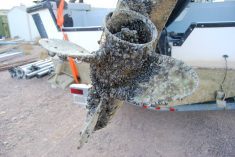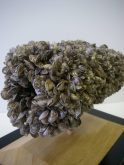*[UPDATED, May 15, 2018] Winter may be the best weapon if zebra and quagga mussels invade Alberta’s waterways, says a new report.
The two species, members of the dreissenid family of mussels, have spread across North America since being found in the Great Lakes more than three decades ago. And while they haven’t invaded Alberta waters so far, there have been close calls, says a report by Paterson Earth & Water Consulting in Lethbridge.
“Alberta is fortunate that dreissenid mussels do not appear to be currently present in any of the province’s water bodies,” the report states, noting mussel-infested boats have been found at inspection stations at Sylvan, Pigeon, Gull, and Wabamun lakes.
Read Also

Farming Smarter receives financial boost from Alberta government for potato research
Farming Smarter near Lethbridge got a boost to its research equipment, thanks to the Alberta government’s increase in funding for research associations.
Paterson Earth & Water was hired by the Eastern Irrigation District and Alberta Agriculture to see if potassium chloride would be an effective way to control mussels if they arrive here.
The threat is huge — zebra and quagga mussels reproduce rapidly and researchers have found up to 100,000 mussels in a single square metre. They fasten on to any hard surface — and each other — when the water flow is slow (less than 1.5 metres per second) and as they build up, they further slow the water while also producing acidic compounds that corrode pipes.
There are ways to battle mussels, but they are neither cheap nor easy, says the Paterson Earth & Water report.
It determined using potash as a source of potassium chloride is the most viable chemical control. But it would cost at least $1.1 million for every treatment and would be a massive logistical operation, needing “at least 60 mobile treatment systems” if the goal was to treat all the pipes each spring.
“The actual costs to treat the 900-plus pipeline segments within the 13 irrigation districts, if required, may be higher because numerous mobile injection systems (manpower, mixing containers, pumps, injection equipment, and fittings) may be required to complete this volume of work within specific time requirements,” the report states. “In addition, the mobile injection equipment may need to be moved many times over relatively long distances, and potentially challenging road networks.”

Each treatment would only be effective for about 30 days and even then “this option would not address the potential accumulation of mussels in producer-owned water supply pipelines.”
Keeping pipes clear
The province is currently seeking registration from the federal Pest Management Regulatory Agency to use potassium chloride for mussel control. But the report says there is another way to kill the invaders — drain irrigation pipes so they dry out and freeze each winter.
“All exposed mussels in underground pipelines will be killed through desiccation during the winter months, because of prolonged exposure and relatively low humidity,” the report states.
However, Mother Nature alone won’t get the job done, and the report recommends both irrigation districts and producers take a number of steps to help her out.
These include determining portions of pipes where water can pool and, if need be, pumping out excess water. (Although some small pools of water will still remain, they shouldn’t hold enough mussels to cause problems with buildup of the creatures and clogging of pipes during the growing season. Potassium chloride could also be used on a more limited scale to deal with pooling.)
The report also recommends assessing the “freezing potential” in underground pipes by installing temperature sensors and possibly pumping cold winter air into pipes below the frost line. Irrigation districts and producers will also need to figure out how to get rid of the shells of dead mussels, although the buildup each season shouldn’t be too great, the report states. New pipelines will need to be installed on grade to minimize low spots and designed so they can be completely drained, properly flushed (to remove mussel shells), and designed so fans can be installed to pump in freezing air.
While the study’s conclusion that an invasion of mussels can be kept in check is good news for producers and irrigation districts, the size of the task is daunting. There are more than 8,000 kilometres of conveyance works plus all the water lines and pivots on farms, “which would also be at risk with an invasive mussel infestation,” the report notes. (Mussels will also breed in surface-water canals during warm months but there should be “100 per cent mortality” in winter, it says.)
Other options
The report also looked at other control options using chemicals but they come with drawbacks. Chlorination has been used to kill mussels, but chlorine can combine with other organic compounds and form carcinogens and the discharge water would have to be dechlorinated. There are issues with treatments such as chlorine dioxide (forms an “extremely poisonous” gas at room temperature), ozone (expensive and dissipates quickly in water), hydrogen peroxide (expensive and only effective with high doses), and potassium permanganate (not toxic enough).
A bigger issue is that there are no chemical treatments for mussel control registered in Canada and “in many cases, the manufacturer will not be willing or able to provide the money, data, or empirical studies required by regulators to gain approval for use,” the study notes.
The report also examines various screens and filtration methods to keep mussels out of pipes, but those, too, come with problems — including cost, screen clogging, maintenance, a drop in water pressure, and the fact that veligers (mussel larvae) are really tiny and can slip through even fine mesh.

Fewer boat launches
The report also recommends that government and irrigation districts step up their efforts to keep zebra and quagga mussels out of Alberta.
The biggest threat comes from mussels hitchhiking on watercraft and the province has set up inspection stations, which have found contaminated boats and watercraft on numerous occasions. But that’s not enough, says the report.
“The current boat-monitoring program at key entry points is beneficial, but may not be totally effective, as boats can continue to enter the province at many locations that may not be fully monitored.”
It recommends reducing the number of boat launch sites on reservoirs and having inspectors at every one “to ensure all incoming boats and other watercraft are free of mussels.”
It also recommends increased monitoring of reservoirs as it “is important to know, as soon as possible, when dreissenid mussels are present.”
The report ‘Dreissenid Mussels and Alberta’s Irrigation Infrastructure: Strategic Pest Management Plan and Cost Estimate’ can be found as a PDF via the Alberta Agriculture website.
More information on protecting infrastructure from mussels can be found on the Alberta Agriculture website.
*UPDATE: A photo previously featured at the top of this page incorrectly stated a photo credit. The photo should have been credited to Marrone Bio Innovations.














